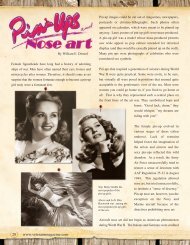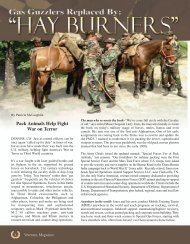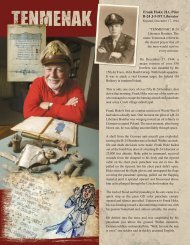In Papua New Guinea, a journalist investigates the - Veterans ...
In Papua New Guinea, a journalist investigates the - Veterans ...
In Papua New Guinea, a journalist investigates the - Veterans ...
You also want an ePaper? Increase the reach of your titles
YUMPU automatically turns print PDFs into web optimized ePapers that Google loves.
excitement. "It revealed <strong>the</strong> sides, and I saw <strong>the</strong> U.S. Army<br />
Air Forces markings, a white star with a large red dot in <strong>the</strong><br />
center—<strong>the</strong>y called it a ‘meatball' in those days, and it was<br />
later phased out because it was thought it might be confused<br />
with <strong>the</strong> Japanese rising sun. And <strong>the</strong> sides were in perfect<br />
condition. It was just spectacular. It was like stepping back<br />
in time, back to 1942, to see <strong>the</strong> plane and <strong>the</strong> ‘meatball'<br />
and <strong>the</strong> door on it, <strong>the</strong> waist door, still propped open 45<br />
degrees. You could imagine <strong>the</strong> crew leaving it."<br />
The crew's fate, in fact, is part of <strong>the</strong> plane's mystique. On<br />
<strong>the</strong> first long-range bombing mission against <strong>the</strong> Japanese,<br />
<strong>the</strong> B-17 took off from Australia just before midnight on<br />
February 22 with <strong>the</strong> aim of attacking ships at Rabaul on<br />
Japanese-held <strong>New</strong> Britain at dawn. From <strong>the</strong> outset <strong>the</strong><br />
mission was plagued by mishaps. With bad wea<strong>the</strong>r, incomplete<br />
maps, novice pilots and mechanical problems, four of <strong>the</strong><br />
nine bombers never even got off <strong>the</strong> ground. "It was dark as<br />
hell at night," recalled Clarence LeMieux, <strong>the</strong> engineer,<br />
now 90 years old and living in Spokane, Washington. "By<br />
<strong>the</strong> time we got <strong>the</strong>re, we lost all <strong>the</strong> o<strong>the</strong>r planes but ours<br />
and one more. We ran into tornadoes—three or four of<br />
<strong>the</strong>m—and we couldn't even see <strong>the</strong> harbor." What happened<br />
next is debated—some say <strong>the</strong> bomb bay doors didn't<br />
open—but in any case <strong>the</strong> plane made a wide circle and<br />
came in for a second run before it dropped its load. Then it<br />
fought off half a dozen Japanese Zeros, had its right wing<br />
shot through by an antiaircraft shell that didn't explode,<br />
climbed to shake off pursuers and headed off. All of this<br />
took a toll on fuel. Capt. Fred Eaton hoped to make it to<br />
Port Moresby, which meant flying over <strong>the</strong> mountains. "I<br />
looked over at <strong>the</strong> fuel gauges, and <strong>the</strong>y were pretty damn<br />
low," said LeMieux. "I said: ‘We're not going to make it<br />
with this fuel.' We saw what looked like a wheat field—all this<br />
pretty grass—and Fred says, ‘Let's put her down here.' "<br />
The belly landing was perfect; only <strong>the</strong> propellers were<br />
bent. But when <strong>the</strong> doors were opened, <strong>the</strong> crew men realized<br />
<strong>the</strong>y had set down in four to eight feet of water. "We<br />
jumped off, and <strong>the</strong> damned stuff was up to our neck,"<br />
said LeMieux. Only one of <strong>the</strong> nine was injured, <strong>the</strong> navigator,<br />
George Munroe, and only slightly. "We had <strong>the</strong>se two<br />
thin sheets of wood in <strong>the</strong> bomb bay to keep <strong>the</strong> wind out<br />
of <strong>the</strong> compartment," Munroe, age 89, recalled from his<br />
home in Falls Church, Virginia. "And I stuck my head<br />
between <strong>the</strong>m and got stuck <strong>the</strong>re when <strong>the</strong> plane<br />
stopped. They pulled me out, and someone said: ‘My<br />
God, your throat's cut.' That kind of shakes you up. But<br />
<strong>the</strong>y had a flask, and <strong>the</strong>y poured water on me, and it<br />
turned out I had little scalp cuts."<br />
For two days, <strong>the</strong> crew members hacked <strong>the</strong>ir way through<br />
razor-sharp kunai grass, trying to rest at night on makeshift<br />
mounds of it, which kept sinking. They were exhausted and<br />
famished. (Their emergency rations had sunk.) When <strong>the</strong>y<br />
finally reached dry land, <strong>the</strong>y were so badly bitten by<br />
mosquitoes <strong>the</strong>y couldn't sleep. Several began to hallucinate.<br />
"A friend and I suddenly saw a mess hall," said Richard<br />
Oliver, <strong>the</strong> bombardier, at 87 long retired and living in<br />
Tiburon, California. "So we decided to get some ice-cold<br />
canned tomatoes. We could see <strong>the</strong> lights up ahead, and we<br />
headed off down <strong>the</strong> path to reach it, when, luckily, somebody<br />
yelled at us and woke us up."<br />
The crew ran into some <strong>Papua</strong>ns chopping wood. "They<br />
didn't seem threatening," said Munroe, "but I carried my<br />
.45 <strong>the</strong> whole time." <strong>In</strong> fact, <strong>the</strong> <strong>Papua</strong>ns were friendly.<br />
They took <strong>the</strong> airmen to <strong>the</strong>ir village for <strong>the</strong> night, <strong>the</strong>n put<br />
<strong>the</strong>m in outrigger canoes and took <strong>the</strong>m downriver to <strong>the</strong><br />
coast, where <strong>the</strong>y were handed over to an Australian<br />
resident magistrate. By now, most of <strong>the</strong> airmen had been<br />
stricken by malaria. After <strong>the</strong>y made several abortive<br />
attempts to depart, a boat finally picked <strong>the</strong>m up and took<br />
<strong>the</strong>m to Port Moresby, arriving <strong>the</strong>re on April 1—thirty-six<br />
days after <strong>the</strong> crash. They were given a week in a hospital<br />
and returned to combat. On many of his 60 subsequent<br />
missions, <strong>the</strong> pilot, Eaton, would often fly over <strong>the</strong> wreck,<br />
and whenever he did, he would circle it and regale his new<br />
crew members with <strong>the</strong> story of how all nine men had<br />
made it back to base alive. The Swamp Ghost's formidable<br />
legend was born.<br />
After <strong>the</strong> war, <strong>the</strong> plane slipped into an oblivion that lasted<br />
almost three decades, until <strong>the</strong> Australian soldiers spotted it<br />
in 1972. They provided <strong>the</strong> tail number to <strong>the</strong> Americans,<br />
who traced it to <strong>the</strong> lost B-17. The crew was told about <strong>the</strong><br />
discovery. Word began to get around, especially after 1979,<br />
when Charles Darby, an early "warbird" collector and<br />
chronicler, printed dozens of photos of it in his seminal<br />
book, Pacific Aircraft Wrecks. Bit by bit, as <strong>the</strong> fad to<br />
recover World War II aircraft took off, trekkers made it to<br />
<strong>the</strong> site. Over time <strong>the</strong> plane was stripped of its instruments,<br />
guns and even its steering assemblies (called flight yokes),<br />
though <strong>the</strong> structure itself, resting in fresh water, remained<br />
remarkably intact.<br />
Among o<strong>the</strong>rs, <strong>the</strong> young Taylan was inspired by <strong>the</strong> Darby<br />
photographs. "Some people set goals to become doctors or<br />
lawyers, but when I saw those pictures, I said to myself:<br />
‘My God, this is like looking back in time. If I do anything<br />
with my life, I've got to get to this airplane.'" He managed<br />
November 2008<br />
39






